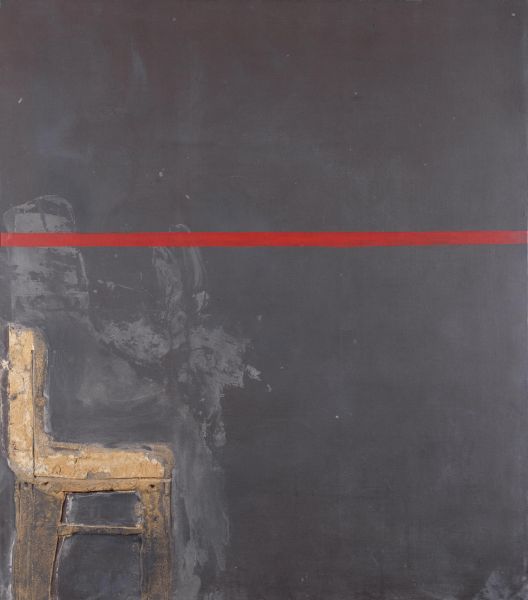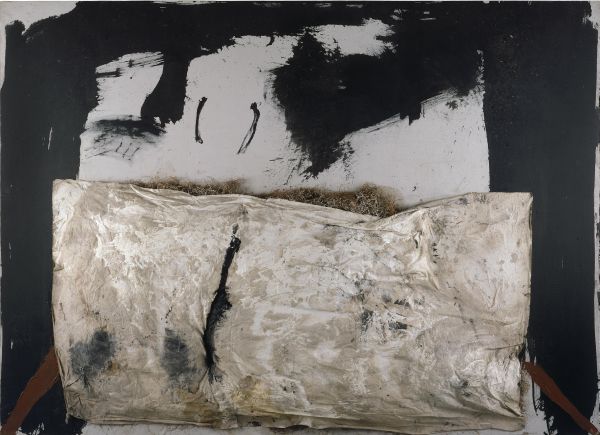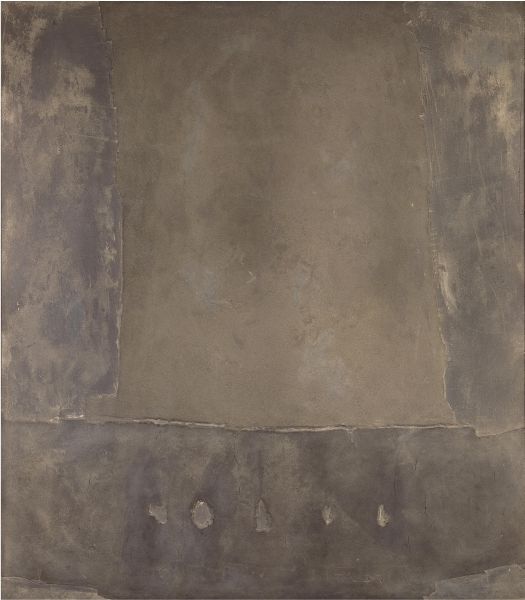Homage to Antoni Tàpies
Tàpies’s work, like that of any genius, is complex, because he created a very personal style full of a symbolism in which he found inspiration in signs of ancient cultures and civilisations, in science and poetry, in Zen philosophy, in telluric landscapes, in poor, humble materials, in insurrection and freedom and in political commitment. Tàpies was a poet and intellectual in the most unforeseeable ways, a restrained expressionist who concentrated on constructing textures, calligraphies, numbers, earthy colours, mysterious transcendent signs and crosses and lines arranged in abstract structures. As a homage to the excellence and intelligence of this great artist, the IVAM is devoting an exhibition to showing six of the most important works in its collection. La ligne rouge (Negre amb línia vermella) (The Red Line [Black with Red Line]), 1963. Mixed media on canvas and wood. This work is a classic of our contemporary age, showing the matter-based Informel art that Tàpies led in his masterly way. We can see in it a genuine mingling of ideas and paths in which there is a blend of the Constructivist tradition, the figurative impulse, experimentation with new materials and a breakaway from two-dimensionality in painting. Gran paquet de palla (Large Bundle of Straw), 1969. Mixed media on canvas. As we can see, in this painting Tàpies does not show objects as they are, incorporating them instead into his personal language. This work forms part of the artistic interpretation that he makes of life and of landscape understood in its simplicity and bareness. In the late sixties and early seventies he intensified his work with objects and brushstrokes that seem to reach beyond the boundaries of the painting. Tàpies had already worked intensely with the object world since the fifties, but at this point, coinciding with Arte Povera, he did so in a new way. Collage de cabells (Collage of Hair), 1985. Mixed media on wood. Tàpies composes this work with a technique that again concentrates on ephemeral real objects and raises them to a higher category. With the incorporation of human hair into the work Tàpies ennobles the actions associated with human nature, to which he devoted part of his exploration as an artist. Amor a mort (Love unto Death), 1980. Acrylic on canvas. Amor a mort shows many examples of the playing with opposites that is a feature of Tàpies’s work. He incorporates the word amor in order to dismantle it and give it an antithetical meaning. This relationship between positive and negative is also marked by the two symbols that he includes at the two extremes of the painting. The contrast between the intensity of black and the opportunity of breaking it apart that he introduces with white is a further indication of this path of opposites that he found so pleasurable. Surface grise rosâtre aux traces noires (Reddish Grey Surface with Black Marks), 1962. Mixed media on canvas. The intellectual control with which the artist impregnates the surfaces of his work, in which there is a predominance of monochrome shapes always close to colours suggesting landscapes of some mysterious imagined territory, is reflected in this large painting in which ochre and earth-coloured areas outdistance all other tonalities. A “non-place” is portrayed on the surface of this picture that shows us a mystical, hermetic world to which access is difficult because of the irrationality of its interpretation. Gris amb cinc perforacions (Grey with Five Perforations), 1958. Mixed media on canvas and wood. With studies like this Tàpies arrived at a matter-based Informel art and earthy abstraction, setting out from a Renaissance Spanish lyricism based on the ascetic poets, subsequently grounded in an oriental mysticism in which he sustained his own enigmatic language: a language of earthy colours, disorderly order, silence and emptiness, piercings and splits in the surface, pigments mixed with all kinds of materials – in short, a language of domestic reality as art. In these expansive structures and planes we see the contrasts so characteristic of his work, with silent, empty spaces and areas full of tensions created by pictorial masses that produce cracks and protuberances on the painted surface. His art, as reflected in this “homage” based on the most important works by him in the IVAM Collection, is constructed to transform the viewer’s inner being, with the artist revealing himself as an alchemist of art who converts matter into dreams, minerals into poetry and shapes into ideas. Thus Tàpies advances from nothingness to totality with the sole express desire of finding a point of encounter with the viewer, who is able to delight in structures that were never thus and would never have existed were it not for the magical manipulation and heart and intelligence of the artist who succeeds in drawing forth pure beauty, the most beautiful ideas and the deepest feelings. This is the simple but complex equation with which we must understand a form of artistic expression, a system of procreation, a way of thinking, an aesthetics, a manner of interpreting the world and a form of progress that express a view of the universe that understands matter as a whole subjected to the constant change and formation that characterise his extraordinary work. Our thanks, Maestro.





